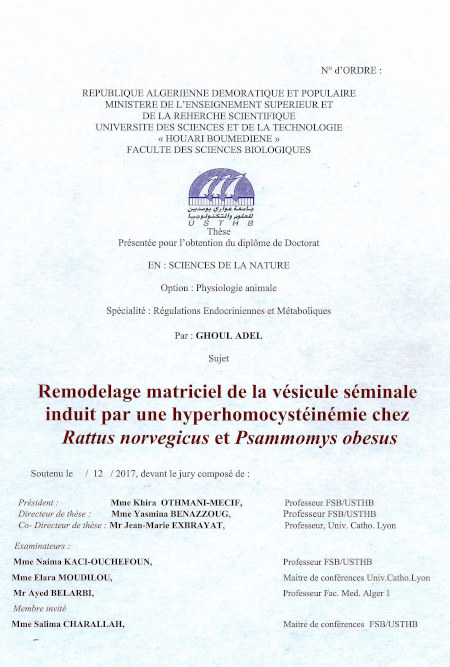Résumé
La présente étude a pour but d’évaluer l’impact d’une hyperhomocystéinémie (Hhcy) sur la matrice extracellulaire (MEC) de la vésicule séminale du rat Wistar et du rat des sables Psammomys obesus.
L’Hhcy expérimentale est engendrée chez le rat Wistar et le rat des sables mâles par une administration chronique de méthionine à raison de 200mg/Kg de poids corporel/jour pendant 6 et 3 mois respectivement. Parallèlement, les rats témoins reçoivent des injections de NaCl à 0,9%. Après sacrifice, la vésicule séminale est prélevée, examinée par différentes approches histologiques, immunohistochimiques, zymographiques et par western blot afin d’apprécier le degré de remaniement de la MEC. Nous avons ciblé les collagènes fibrillaires (Types I et III), les métalloprotéinases (MMP-2, -3, -7 et -9) et leurs inhibiteurs tissulaires TIMPS (TIMP-1 et -2), principaux acteurs de l’homéostasie matricielle. L’apoptose a été aussi examinée via la mise en évidence de la caspase 3 activée et par la méthode Apostain.
Au niveau tissulaire, l’étude a montré que l’Hhcys a engendré une fibrose ou accumulation des composants de la MEC, principalement les collagènes, chez les deux modèles animaux. L’étude immunohistochimique des collagènes I et III a confirmé leur implication dans la fibrose. De plus, nous avions noté un déséquilibre de la balance MMPs/TIMPs chez le rat Wistar et Psammomys obesus hyperhomocystéinémique. Ce remaniement matriciel est accompagné d’un dysfonctionnement cellulaire marqué par une apoptose caspase 3épendate, des cellules épithéliales.
Mots-clés : Homocystéine, méthionine, rat Wistar, Psammomys obesus, MMPs, TIMPs.
Abstract
The present study aimed to evaluate the impact of hyperhomocysteinemia (Hhcy) on the extracellular matrix (ECM) composition of the seminal vesicle of Wistar rat and Psammomys obesus.
The experimental Hhcy was induced in male Wistar rats by chronic oral methionine administration (200 mg/kg bw/day for 6 months). In Psammomys obesus, the Hhcy was induced by the intraperitoneal injection of methionine (200 mg/kg bw/day for 3 months) dissolved in physiological saline solution. At the same time, the control rats were injected only with saline solution. We observed that plasma homocysteine levels increased in Wistar rat and Psammomys obesus. This Hhcy appeared to decrease the weight gain in experimental animals, compared to the controls. At the end of each treatment, animals were dissected under anesthesia by urethane; seminal vesicles were removed, and then examined by different technical approaches: histology, immunohistochemistry, zymography, western blotting. In order to assess the remodeling degree of the ECM, particularly fibrosis, types I and III collagen, metalloproteinases (MM9-2, -3, -7 and -9), and their tissue inhibitors (TIMPS-1 and -2) were the targets considered such as the main players in matrix homeostasis. Apoptosis was so examined by the “Apostain’s method” and by the detection of active caspase 3. The histological study showed that Hhcy produced an accumulation of ECM components in both animal models. In addition, the immunohistochemical study of collagen I and III confirmed the histological results, except for type III collagen, which decreased in the sand rat. Western blotting analysis confirmed the results previously obtained by immunohistochemistry. Indeed, an overexpression of MMPs was noted in both groups of hyperhomocysteinemic animals as compared to controls, accompanied with a decrease of TIPMP-1 in all groups. On the other hand, TIMP-2 increased in Wistar rats and decreased in hyperhomocysteinemeic sand rats.With zymography study, samples from Hhcy rats showed higher levels of MMP-2 and MMP-9 compare to control rats, confirming WB results. In addition, results of apoptosis study showed more apoptotic nuclei of epithelial cells in hypetrhocysteinemic rats compared to controls.
Keywords: Homocysteine, methionine, MMPs, Psammomys obesus, TIMPs, Wistar rat.


